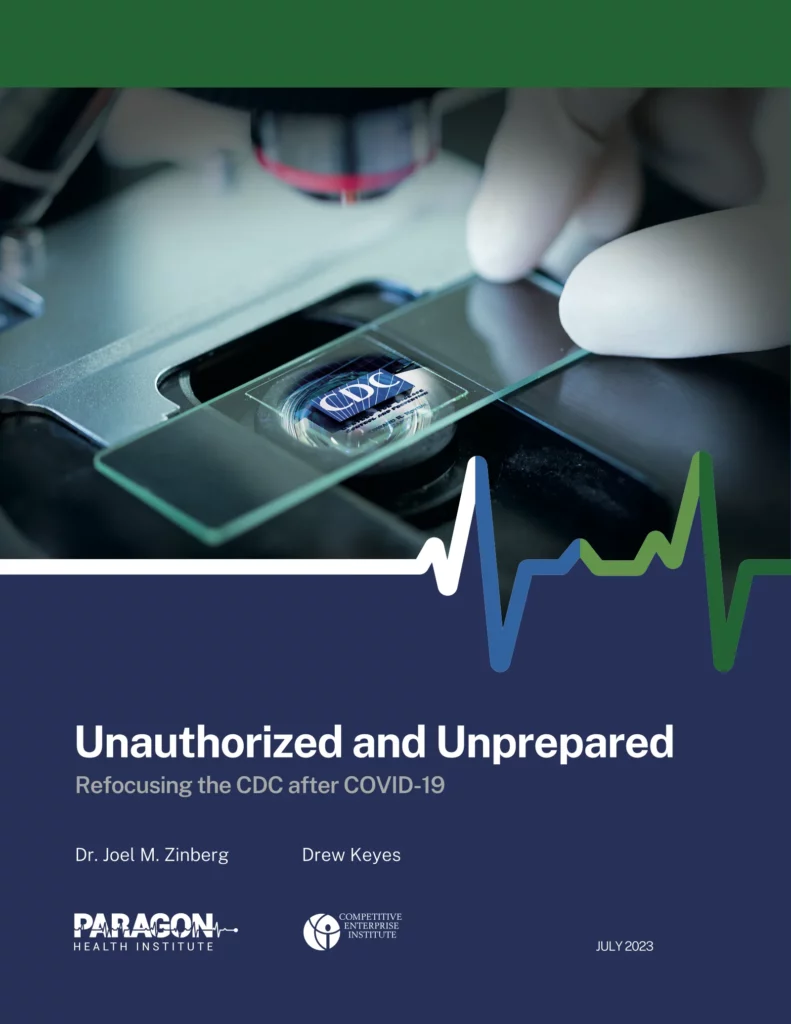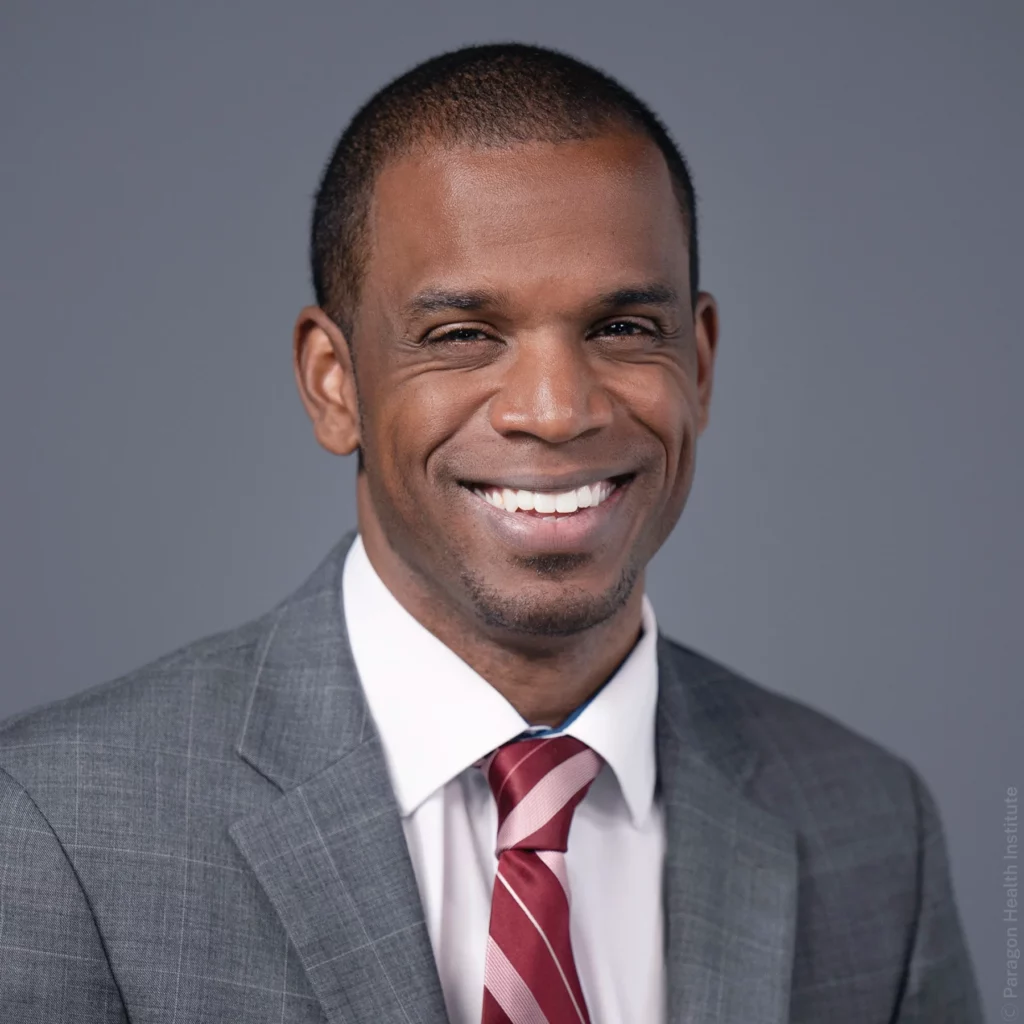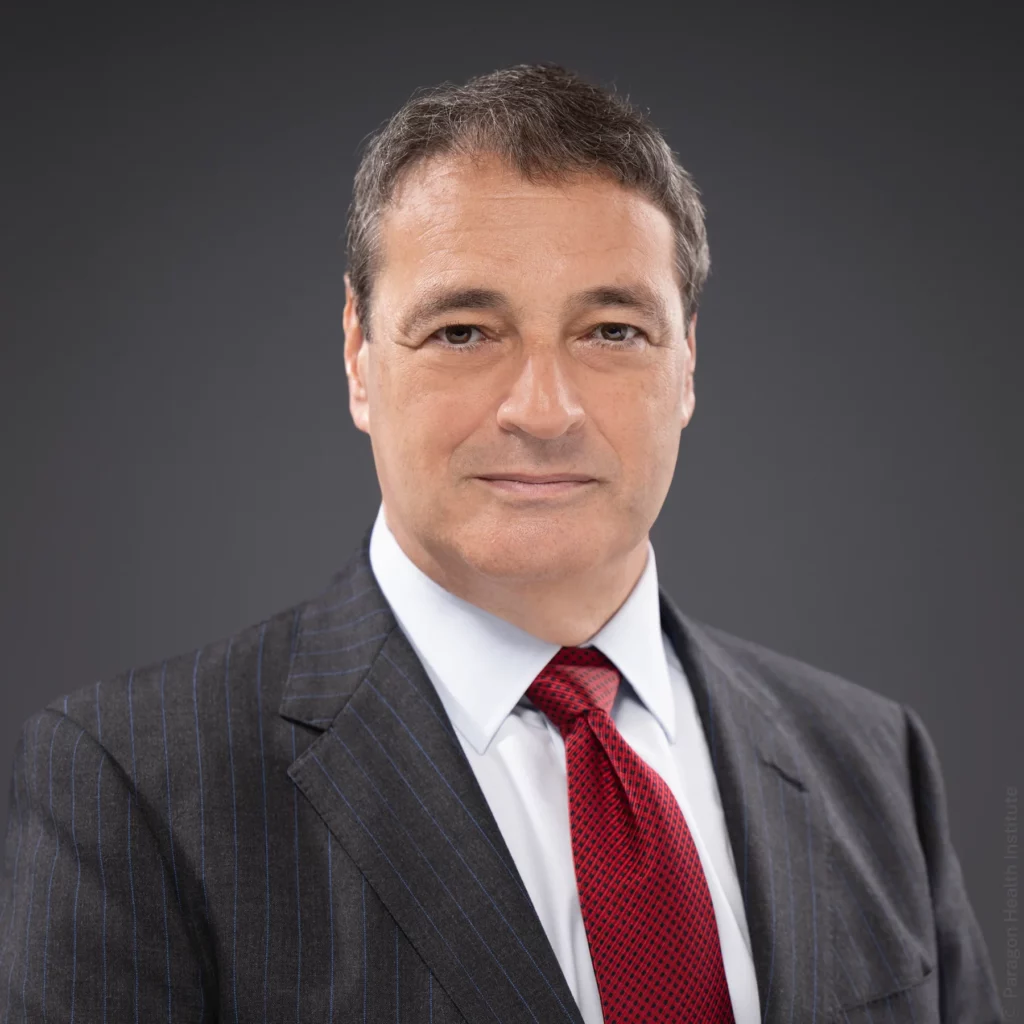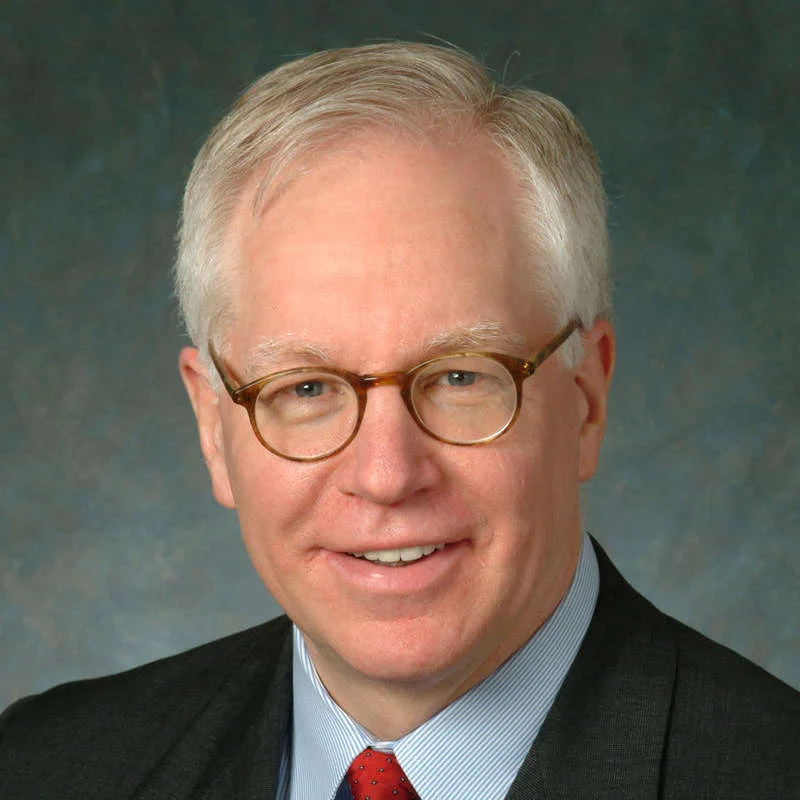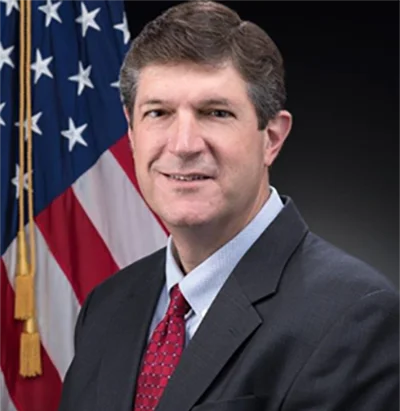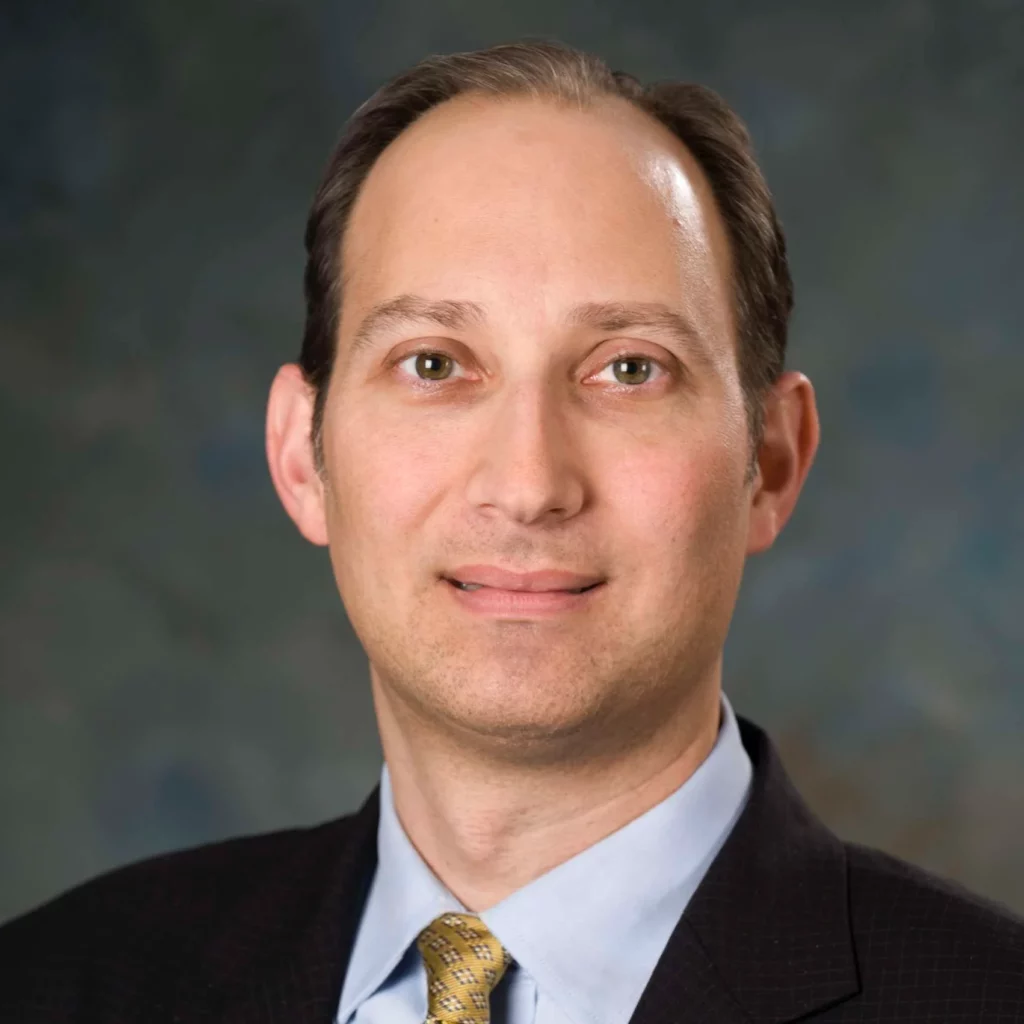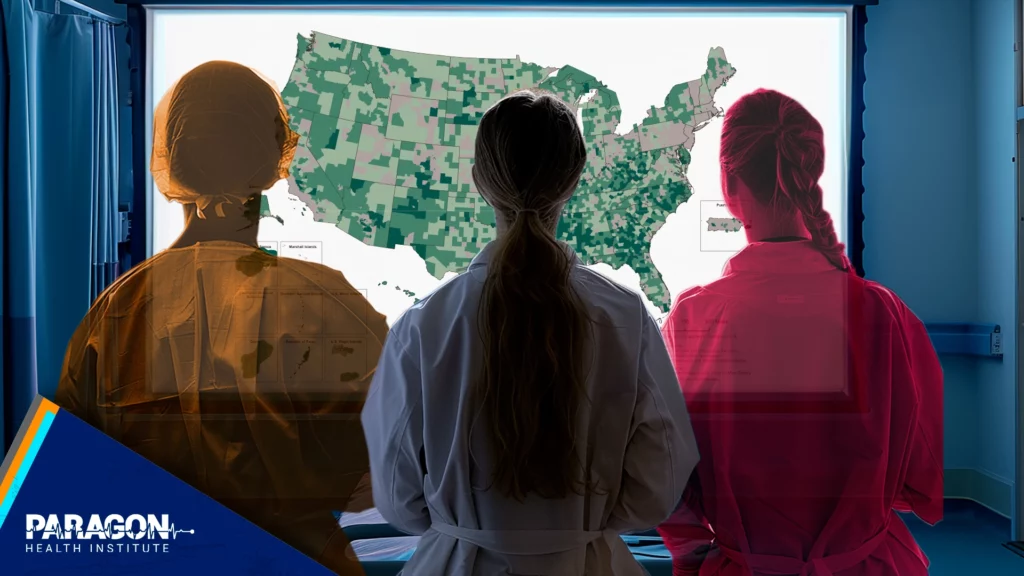Reforming Government. Empowering Patients.
Navigation
Unauthorized & Unprepared
Refocusing the CDC after COVID-19

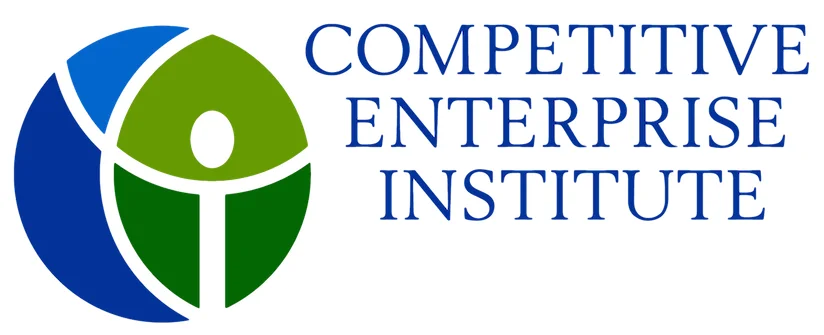
The Paper
The Centers for Disease Control and Prevention, the nation’s preeminent public health agency, has acknowledged that it failed during the COVID-19 pandemic. This paper examines why and suggests how the CDC can be reformed and refocused.
Key Takeaways
- The CDC’s lack of congressional authorization has led to mission creep, with the agency expanding beyond its core mission of controlling and preventing communicable disease outbreaks, becoming large and diffuse.
- The agency’s broadened focus includes many areas that overlap with responsibilities of other agencies, leading to unnecessary redundancies, diverting resources away from its primary purpose.
- The CDC’s failures during the COVID-19 pandemic, such as inadequate testing and flawed communication, are partly attributed to its lack of focus on infectious disease outbreaks, having been distracted by its expanded mission.
- The CDC’s missteps undermined public trust and demonstrated the need for a more focused and less political public health agency.
- The paper argues that Congress, not the CDC, should define the agency’s role, and suggests comprehensive authorization to reaffirm its core mission while eliminating off-mission priorities.
- The CDC must reform its communication strategies, improve data collection, and institute good guidance practices to restore trust and prepare for future pandemics effectively.
Executive Summary
What we Found
The basic problem was CDC mission creep, abetted by the lack of congressional authorization for the agency. Because the CDC has never been fully authorized by Congress, it lacks goals, circumscribed powers, and effective oversight. This led to a rapid and haphazard expansion of its responsibilities as the CDC became a large, diffuse agency with priorities that are far afield from its core mission of controlling and preventing communicable disease outbreaks.
CDC is now a collection of centers and programs that are disconnected from each other and from state and local authorities, and duplicative of programs in other agencies and departments. These redundancies are unnecessary, costly, and divert the CDC from its primary purpose. Just a small fraction of CDC resources is devoted to communicable disease threats. The lack of focus left the agency unprepared for the pandemic and distracted it from an effective response.
Why it Matters
The CDC’s failures during the pandemic undermined public trust. Americans deserve a more focused and less political public health agency. Unless the CDC is reformed and refocused on its core mission, it will be unprepared to act effectively in future pandemics.
Policy Suggestions
We cannot rely on CDC to reform itself—bureaucracies rarely do. Congress’ job is to define CDC’s role. Instead of blindly increasing funding, Congress should comprehensively authorize the CDC for the first time and reaffirm the agency’s core mission. Congress must delineate agency’s responsibilities and cut back on areas where the CDC does not have expertise and duplicates other authorized agencies’ programs. Congress should remove off-mission priorities—such as broad prevention initiatives, social determinants of health, environmental issues, and violence prevention—to agencies where they can be, or already are better addressed. These reforms would help restore public trust and make the CDC more effective and better prepared to combat the next pandemic.
Introduction
In August 2022, Dr. Rochelle Walensky, director of the Centers for Disease Control and Prevention acknowledged that “For 75 years, CDC and public health have been preparing for COVID-19, and in our big moment, our performance did not reliably meet expectations.”1 That is an understatement. The question is why what was once the nation’s preeminent public health agency failed so badly and what can be done to make sure that it performs better in the future.
In a separate video to CDC staffers, Walensky admitted, “To be frank, we are responsible for some pretty dramatic, pretty public mistakes — from testing, to data, to communications.”2 Indeed, those failures were legion. The agency failed to adequately ramp up its testing capabilities at the onset of the pandemic, allowing the country to fall irreparably behind in its initial response. Its data collection and communication with state and local health authorities were dysfunctional. It relied on faulty science in advancing damaging guidance on masking and social distancing that led communities that trusted its authority to impose mandates that did more damage than good. It communicated incomplete and inconclusive data as scientific fact, and suppressed opinions that didn’t fit with its narrative. Many, on both sides of the political spectrum, came to believe that the agency’s actions were politically motivated, furthering the distrust that came from its underlying failures.
After reviewing the history, organization, and pandemic performance of the CDC, we identify the basic problem as mission creep, abetted by the lack of congressional authorization for the agency. The CDC has grown into a large, diffuse agency with priorities that are far afield from its core mission of controlling and preventing communicable disease outbreaks. The profusion of programs left the agency unprepared for the pandemic and distracted it from an effective response.
The first section of this paper reviews the history and statutory background of the CDC. The agency was founded in 1946 as the Communicable Disease Center with a $10 million budget and fewer than 400 employees. Its original mission was to prevent the spread of malaria and, soon after, expanded to include the control and prevention of other communicable diseases.
The CDC has since grown into a huge agency — with a budget exceeding $9 billion3 and more than 15,000 employees — that now addresses such diverse and fashionable concerns as environmental justice and “health equity.” This is, in large part, a consequence of the fact that the CDC, unlike other major agencies, has never been fully authorized. It was created through the executive branch and has since expanded in the executive branch largely through unauthorized appropriations by Congress.
The next section describes how the lack of direct congressional authorization specifying the agency’s goals, circumscribing its powers, and committing to effective oversight, along with aggressive efforts by the CDC’s early directors to expand the agency’s purview, and the willingness of executive branch officials to delegate authority to CDC, have led to mission creep—a rapid and haphazard expansion of the agency’s responsibilities beyond its original mission of combating communicable diseases. The result has been a disparate collection of CDC centers and programs that are disconnected from each other and from state and local authorities. Many CDC centers, institutes, and programs duplicate programs in other agencies and departments that have been specifically tasked with providing those goods and services by Congress. Other CDC priorities are barely health issues at all and have long been addressed by social service and law enforcement agencies. These redundancies are unnecessary, costly, and divert the CDC from what should be its primary mission, protecting the nation from communicable diseases. Only a small fraction of CDC resources is devoted to communicable disease threats.
The following section describes how CDC’s expansion beyond its core mission of combating communicable diseases into other health and non-health related areas led to a lack of focus by the agency during the pandemic with disastrous results. CDC’s performance was flawed throughout the three years of the pandemic and often seemed to be dictated more by political than scientific considerations. Even in the midst of the COVID-19 pandemic—the biggest public health crisis in over 100 years—the CDC was launching initiatives to address the “social determinants” of health and promote health equity.
There will be future pandemics—it is not a question of if but when. If the next organism is more virulent than the SARS-CoV-2 virus responsible for COVID-19 it could result in a mass casualty, civilization altering event.
The time has come to reform the CDC so that it is prepared for the next pandemic. We outline why we cannot rely on the agency to reform itself. Bureaucracies in general are loath to reorganize, especially if it might means downsizing and losing resources. A previous reorganization effort by the CDC 20 years ago was an abject failure. The CDC has already misdiagnosed the causes of its poor pandemic performance, blaming “communications” failures and “underfunding.” Unsurprisingly, both the agency and President Joe Biden are seeking large funding increases for the CDC.
Instead of blindly increasing funding, Congress should comprehensively authorize the CDC for the first time, and in doing so, reaffirm the agency’s original mission to combat communicable, infectious diseases. Congress must do the hard work of defining the agency, outlining its core mission and cutting back on the many areas where the CDC does not (and should not) have expertise and simply duplicates other authorized agencies’ programs. Other priorities, such as broad prevention initiatives, social determinants of health, environmental issues, and violence prevention that are outside the scope of CDC’s core competency and are addressed by efforts at the National Institutes of Health and other Department of Health and Human Services agencies, as well as other agencies outside of HHS, should be moved out of the CDC. And areas that rightly belong within CDC should be returned to it.
With or without legislation, CDC must rededicate itself to its core mission. That will include updating data collection, synthesis and dissemination systems. Good guidance practices, such as those followed by the Food and Drug Administration, should be instituted. These measures will restore trust in the CDC, make it a more effective public health agency, and ensure that it is prepared to combat the next pandemic.
CDC’s Statutory History
The CDC was originally created as the Communicable Disease Center by executive action on July 1, 1946, as a division of the Bureau of State Services of the U.S. Public Health Service (PHS).4 It had a $10 million budget and fewer than 400 employees who had worked for CDC’s predecessor agency, the wartime Malaria Control in War Areas.5 The agency’s original mission was to diagnose and control communicable diseases through the application of epidemiological science and, with that goal in mind, to serve the states with “training, investigations, and control technology” and surveillance of disease-related threats.6
The U.S. Constitution gives the power to determine spending—the so-called “power of the purse”—to Congress.7 Both the House and the Senate have chosen through their rules and historical practices to exercise this authority in a two-step process of authorization and appropriation. Congress normally first enacts “[a]n authorizing measure [that] can establish, continue, or modify an agency, program, or activity for a fixed or indefinite period of time. It also may set forth the duties and functions of an agency or program, its organizational structure, and the responsibilities of agency or program officials.”8 This is generally followed by an appropriation measure to provide funds for the authorized agency, program, or activity.9
Unlike other significant agencies, Congress has never authorized the CDC.10 There is no single enabling statute that defines the agency’s mission and structure.11 Its programs are predominantly authorized by general and program-specific laws, mostly in the Public Health Service Act (PHSA), that give executive branch officials broad spending and organizational authority. CDC also regularly receives supplemental or one-time appropriations in response to public health emergencies.12 As the Congressional Research Service recently observed, “Given CDC’s mix of general and specific authorizations, appropriations play a central role in guiding the agency’s policy priorities.”13 This created an outsized role for appropriators without a regular reauthorizing process to give Congress a consistent oversight role.
Initially, the U.S. surgeon general oversaw the CDC.14 Congressionally approved reorganization plans in 195315 and 196616 granted authority to determine the organization of PHS agencies to the secretary of the Department of Health, Education, and Welfare (HEW) (which became Health and Human Services or HHS in 1979). The HEW secretary established the Center for Disease Control in 1970, replacing the preexisting Communicable Disease Center. In 1981, after extensive reorganization, the word Center became Centers. Congress added the words “and Prevention” in 1992, giving the agency its current name, but allowed the well-known three-letter acronym CDC to continue to be used for official purposes.17
Only three of the current 12 CDC centers and institutes18 are explicitly authorized by statute: the National Institute for Occupational Safety and Health (NIOSH) authorized by the Occupational Safety and Health Act of 1970, Section 22;19 the National Center for Health Statistics, established in PHSA Section 306;20 and the National Center on Birth Defects and Developmental Disabilities, established in PHSA Section 317C.21 Only the last one (Birth Defects) was specifically placed within CDC by statute. The other two were established within HEW and its successor HHS and subsequently placed within CDC by the secretary. In addition, the Agency for Toxic Substances and Disease Registry (ATSDR), a separate operating division overseen by the CDC director, was established by the Comprehensive Environmental Response, Compensation and Liability Act of 1980.22
Some statutes specify that the secretary of HHS shall23 or may24 have the CDC carry out a program. More often, program authorizations are directed to the HHS secretary, but carried out by CDC by delegation. Other CDC programs have received appropriations without ever having been explicitly authorized.
The percentage of CDC’s budget that was appropriated without congressional authorization was 40 percent in FY 2010, the first year for which data is available. The figure dropped for a few years as large, temporary demonstration projects were authorized, but has since grown from 14 percent in FY 2014 to 48 percent in FY 2023 as authorizations lapsed and additional appropriations without authorizations were made.25 This has resulted in a hodgepodge of programs—a small number explicitly authorized for CDC; others authorized for HHS but placed haphazardly within CDC; and increasing numbers dependent on congressional appropriations without current authorizations—without any overriding vision of how they fit together or interact with state and local authorities. The programs are often siloed off from one another and many do little to advance the agency’s core mission.
Mission Creep
The lack of direct congressional authorization, aggressive efforts by the CDC’s early directors to expand the agency’s purview, and the willingness of executive branch officials to delegate authority to CDC, led to a rapid expansion in the agency’s responsibilities beyond its original mission of dealing with communicable diseases.26 CDC’s own publication, the Morbidity and Mortality Weekly Report (MMWR), noted in 1992, “[t]he scope of mission expanded rapidly to include programs in areas such as occupational and environmental health, family planning and reproductive health, and chronic diseases.”27
The agency’s expansion was aided by its early successes in its core areas including successfulresponses to malaria, polio, and multiple pandemics, and its role in the eradication of smallpox.28 It gained the trust of state and local health departments, Congress, and, for most of its history, the American public.
With this trust in hand, the CDC “grew by acquisition” adding programs in communicable disease and non-communicable disease areas alike.29 CDC leaders, unfettered by congressional guidance, took an expansive view of public health and their mission. The agency’s various name changes, in 1970 and 1981 by executive branch action and in 1992 by legislation, were not an expression of congressional intent as much as a recognition that “[a]s the scope of CDC’s activities expanded far beyond communicable diseases, its name had to be changed.”31
These efforts were, in part, an intentional push towards a broader view of public health. In 1979, Surgeon General Julius Richmond published a report that advocated a refocused narrative on health promotion. Healthy People: The Surgeon General’s Report on Health Promotion and Disease Prevention began a concerted push by public health bureaucrats to broaden the scope of their efforts.31 It addressed everything from gun violence to smoking to neglectful parenting. That year CDC convened a conference of experts that translated the report into a set of 226 goals to reach by 1990.32 In today’s parlance, it argued for addressing the social determinants of health which meant extending the CDC’s mission beyond its historical and founding scope into nonmedical areas that might influence health.33
CDC priorities now include addressing “the public health consequences of the climate crisis,” “reducing racial disparities in public health,” addressing “the social determinants of health, conditions in the places where people live, learn, work, and play” and “increases in injury and violence prevention programs that will help to address the growing crisis of domestic, sexual, and gun violence.”34 Recent research on the agency’s budget “suggests that no more than eight percent of its workforce is engaged in traditional efforts related to identifying and controlling contagious biological threats.”35
As a result of this mission creep, the CDC is providing public goods and services that are also being provided by other agencies and departments that have been specifically tasked with providing those goods and services by Congress. These redundancies are unnecessary, costly, and divert the CDC from what should be its primary mission, protecting the nation from communicable diseases.
CDC duplicates work done by multiple other government institutes, centers, departments and agencies, many of which enjoy large budgets. Some examples include:
- The CDC National Center for Chronic Disease Prevention and Health Promotion has a broad mission to prevent mortality, morbidity and disability across multiple disease areas including cancer, heart disease, stroke, diabetes arthritis, oral disease, and reproductive outcomes, and to ameliorate major risk factors including tobacco use, poor nutrition and physical inactivity.36 Its mission is similar to multiple NIH Institutes that have large budgets and which were mostly established before CDC expanded its ambit beyond communicable diseases. These include the National Cancer Institute, established in 1937 and currently with a $7.3 billion budget, which functions as “…the federal government’s principal agency for cancer research and training.”37; the National Heart, Lung, and Blood Institute, established in 1948 and currently with a nearly $4 billion budget, with a mission to promote research and training on the prevention and treatment of heart, lung, blood, and sleep disorders38; the National Institute of Neurological Disorders and Stroke, established 1950 to support and perform neuroscience research, support training programs, and to disseminate scientific discoveries to the public, health professionals, researchers, and policy-makers, with a current budget of $2.8 billion39; the National Institute of Diabetes and Digestive and Kidney Disease, established 1950, currently with a $2.3 billion budget41; the National Institute of Arthritis and Musculoskeletal and Skin Diseases, established in 1986, current budget over $600 million41; the National Institute of Dental and Craniofacial Research, established in 1948 with a current $475 million budget and a mission “…to improve dental, oral, and craniofacial health through research and research training, and by promoting the timely transfer of knowledge gained from research to the public.”42; and the Eunice Kennedy Shriver National Institute of Child Health and Human Development was established 1962 with a mission “… to lead research and training to understand human development, improve reproductive health, enhance the lives of children and adolescents, and optimize abilities for all.”43
- Outside of the NIH institutes, “[t]he Center for Nutrition Policy and Promotion (CNPP) was created within the U.S. Department of Agriculture in 1994. … to improve the health of Americans by developing and promoting dietary guidance that links scientific research to the nutrition needs of consumers”44; the Family Smoking Prevention and Tobacco Control Act,45 enacted in 2009, created the FDA Center for Tobacco Products with broad authority to “ develop policy, issue regulations, conduct research, educate Americans on tobacco products, and make decisions on whether new tobacco products and claims can be marketed”46; and the President’s Council on Sports, Fitness & Nutrition, established in 1956 to promote the benefits of physical activity and healthy eating.47
- The CDC National Center for Injury Prevention and Control with a mission to prevent non-occupational injuries and violence. Its programs address suicide prevention, drug overdoses, child abuse, motor vehicle safety, and traumatic brain injury.48 They are duplicated by NIH Institutes and other agencies. Inside the NIH: The National Institute of Mental Health “is the lead federal agency for research on mental disorders” and its focus includes suicide prevention. It was established 1948 and has a current budget above $2 billion49; the National Institute on Drug Abuse with a current budget of nearly $1.7 billion was established in 197450; and the Eunice Kennedy Shriver National Institute on Child Health and Human Development’s areas of interest include pediatric injury, sudden infant death syndrome and traumatic brain injury. Outside the NIH: The National Highway Traffic Safety Administration, established by the Highway Safety Act of 1970, is “[d] edicated to achieving the highest standards of excellence in motor vehicle and highway safety, …to help prevent crashes and their attendant costs, both human and financial.”51; the Consumer Product Safety Commission, established by Congress in 1972,52 “works to save lives and keep families safe by reducing the unreasonable risk of injuries and deaths associated with consumer products” by issuing and enforcing mandatory standards, recalling or banning dangerous products, researching potential product hazards, and educating consumers and manufacturers;53 and the Substance Abuse and Mental Health Services Administration (SAMHSA) is a separate agency within HHS, established by Congress in 1992,54 with four centers that deal with substance abuse treatment, substance abuse prevention, mental health services (including suicide prevention), and behavioral health statistics and quality and a budget of $7.5 billion (the administration is requesting $10.8 for FY 2024).55
- The CDC National Institute for Occupational Safety and Health (NIOSH) has virtually the same mission of assuring safe working conditions as the Occupational Safety and Health Administration (OSHA). There is significant overlap between the two agencies but different emphases. NIOSH is supposed to conduct research in order to establish recommended occupational health and safety standards. OSHA is more of a regulatory agency that sets and enforces occupational health and safety standards. Both were authorized by the Occupational Safety and Health Act of 1970 which placed OSHA as an agency in the Department of Labor and placed NIOSH in HHS.56 The HHS secretary transferred NIOSH into CDC in 1973. Arguably, an occupational safety institute could find a better home than in an agency devoted to combating communicable diseases.
- The Community Preventive Services Task Force (CPSTF) was established by HHS in 1996 to develop scientifically based guidance on the efficacy of community-based health promotion and disease prevention interventions. While the CPSTF is presumably “an independent, nonfederal panel of public health and prevention experts” it staffed by the CDC57 which provides the CPSTF with scientific and administrative support. Indeed, a video on the CPSTF home page from CDC director Dr. Rochelle Walensky describes the agencies’ relationship as “a partnership.”58 Yet the CPSTF has the exact same mission as the Agency for Healthcare Research and Quality (AHRQ). AHRQ’s was authorized by Congress in 1989 under a different name as one of HHS’ 12 operating divisions, “…to enhance the quality, appropriateness, and effectiveness of health services, and access to such services, through the establishment of a broad base of scientific research and through the promotion of improvements in clinical and health system practices, including the prevention of diseases and other health conditions.”59
The CDC also shares responsibilities during disease outbreaks with the Administration for Strategic Preparedness and Response (ASPR)60, FEMA, the Department of Defense, and the Department of State. The various agencies’ roles, and how they should interrelate, are not clearly defined.
Conversely, there are multiple centers in CDC that fall within its historical core mission of combating infectious and communicable diseases—the National Center on Emerging and Zoonotic Infectious Diseases; the National Center for HIV, Viral Hepatitis, STD, and TB Prevention; the National Center for Immunization and Respiratory Diseases; the Center for Forecasting and Outbreak Analytics—that seem to be duplicated by other agencies such as NIH’s National Institute of Allergy and Infectious Diseases. Arguably, those other agencies’ functions belong at the CDC.
Without a congressionally defined core mission, the CDC has broadened its efforts into areas that are, at best, only marginally related to public health. Combating climate change61 and “systemic racism” may be important goals but their relationship to health in general, and to communicable diseases in particular, is somewhat attenuated. The agency claims that long-standing, systemic racism influences various social determinants of health resulting in higher rates of illness and poorer outcomes for a wide range of health conditions.62 Even if this diagnosis is true—and there are reasons to doubt it63—racism and climate change are not subjects in which the CDC has particular expertise. Climate change and racism are already addressed by a multitude of other federal agencies and statutes.
The listings of duplications above are not exhaustive. There are other areas of agency overlap. Nor is it meant to suggest that there is complete overlap between the CDC and other agencies. But the overlaps and duplications are substantial. The CDC centers and institutes may be addressing important issues, but it is not clear that duplicating the efforts of better funded, more expert agencies that were specifically tasked by Congress to address those issues provides any net benefit.
These duplications have little upside. Unlike the private sector where competition weeds out underperformers, competition between government agencies duplicates efforts and wastes money. Underperforming government agencies are almost never downsized, much less closed down.
A large portion of CDC’s annual budget is awarded as external grants or cooperative agreements. The majority (almost 60 percent) goes to state and local health departments with the balance going to “other entities, including international governments and organizations; tribal governments and organizations; academic and research institutions; and nonprofit organizations.”64 Much of the spending by duplicating agencies also goes to external financial assistance to non-agency actors. This creates the possibility of waste with two or more agencies funding the same research or program objective. There is also a risk that duplicative funding will not be additive but rather result in contradictory programmatic and research agendas.
Mission Creep and Pandemic Failures
The COVID-19 pandemic experience demonstrates the deleterious impact of the CDC’s mission creep. Duplicative work and priorities that are only marginally connected to public health left the agency unprepared to address its core mission and distracted the agency from completing that mission when the pandemic began. Former associate FDA commissioner Peter Lurie, described the CDC as “an agency that has been waiting its entire existence for this moment,” yet, he lamented, that when the pandemic arrived the CDC “flub[bed] it. It is very sad. That is what they were set up to do.”65
The “flubs” started early and continued throughout the pandemic: A CDC data system that state and local officials relied on for notifications of passengers who might pose infectious disease threats was so antiquated that state and local officials found it unusable. When the system went offline in mid-February 2020, local officials who asked how to deal with the possibility that infected, incoming passengers might slip away, were reportedly told by CDC personnel “[j]ust let them go.”66 CDC concentrated its surveillance efforts on China and Asia, missing the early spread from Europe that devastated New York.
CDC impeded testing capabilities at the outset of the pandemic by distributing a faulty test and prohibiting use of other effective tests, causing efforts to combat the outbreak to fall hopelessly behind.67 The test was defective because it had become contaminated due to the CDC’s failure to observe sterility protocols, skipped quality control checks, and insistence on shipping the test even after noting anomalies in the test results.68
CDC was repeatedly slow to update its guidelines and public information based on evolving scientific information that showed, for instance, that deep cleaning and surface disinfection provided no real benefit,69 that disease could be spread by airborne transmission,70 and that natural immunity resulting from infection was real and provided protection that is as good or better than vaccine protection.71
The agency relied on faulty science in advancing damaging guidance on social distancing, masking and school closures that led communities that trusted its authority to impose mandates that did more damage than good.72 CDC’s school reopening guidance elicited a public rebuke from the authors’ of a study it cited.73 CDC set and maintained arbitrary, overly cautious guidelines on mitigation measures such as masking and only revised them long after newer, highly contagious variants made them irrelevant and long after most states and localities had dropped them.74
The agency communicated incomplete and inconclusive data as scientific fact75 and excluded people with opinions that challenged its preferred narrative. It maintained a COVID-19 testing mandate for air travelers entering the United States well past the point that it was necessary while at the same time ending enforcement of Title 42, the public health measure that barred untested, illegal immigrants from staying in the country.76 And the agency imposed a scientifically and legally dubious77 nationwide eviction moratorium until stopped by the courts.78
Throughout the pandemic, CDC’s communications with members of the public and the public health community were tardy and confusing.79 CDC’s deficiencies in data collection, synthesis and dissemination were so obvious that more people relied on the data dashboard created by a first-year PhD student at Johns Hopkins University80 for up-to-date information than on CDC publications.
These mis-steps had real consequences. CDC’s data collection and communication problems, along with its early testing debacle, led to greater disease spread which elicited lockdown measures that were prolonged by CDC’s faulty scientific advice. These created severe economic costs which disproportionally impacted those who were less educated and less affluent81 and feelings of social isolation and estrangement, which led to other mental and physical health issues, especially among the elderly.82 CDC’s flawed school reopening guidance led to prolonged school closures and delays in return to in-person instruction resulting in substantial educational83 and economic losses84 that were worse for disadvantaged and minority students.85 CDC’s own data suggest that children who received virtual or combined instruction also experienced decreased physical activity and decreased mental and emotional health compared with children who received in-person instruction.86
CDC’s mis-steps and willingness to disseminate dubious advice, misleading statements, and demonstrably false assertions87 undermined public confidence and the ability of the agency to influence peoples’ behavior. The fact that many of these actions appeared to be politically rather than scientifically motivated,88 amplified the distrust that resulted from the agency’s failures.89 In a particularly infamous episode, e-mails obtained by a Freedom of Information Act request showed that the CDC allowed Randi Weingarten, president of the American Federation of Teachers, and other union officials to review and edit new February 2021 school reopening guidance that slowed the return to in-person learning. AFT suggested language was inserted nearly verbatim into the final text of the CDC document.90
Former CDC Director Robert Redfield and former Assistant Secretary for Health Brett Giroir both pointed to the CDC’s lack of focus on infectious disease outbreaks as a cause of its poor pandemic response in interviews with the House Select Subcommittee on the Coronavirus Crisis.91 That lack of focus was attributable to the agency’s mission creep.92
The agency’s lack of focus was exemplified by its review of pandemic performance and suggestions for agency reform. The resulting report—CDC Moving Forward, released in August 2022—boasts that, “Just three months into her tenure in April 2021, [Walensky] declared racism as a serious public health threat and established the internal process, CORE, to integrate health equity into the fabric of the agency.”93 The CORE (Cultivate, Optimize, Reinforce, Enhance) initiative was “the framework for embedding health equity into CDC’s science and interventions, and diversity, equity, inclusion, and accessibility (DEIA) into CDC’s workforce, culture, and infrastructure.”94 The agency set aside $2.25 billion to address COVID-19 related health disparities.95
April 2021 was also when the government was struggling to roll out the new COVID vaccines and convince a skeptical populace to use them. Only a third of people had received at least one dose and about one in five had completed the two-shot primary series.96 Given the importance of vaccine distribution to reduce hospitalization and death, this was not the most opportune time for CDC to focus on racism and health equity. Earlier in the pandemic, in July 2020, as the agency was still struggling to distribute accurate tests and to formulate and promulgate reliable guidelines, it took time to announce the CDC COVID-19 Response Health Equity Strategy.97
CDC mis-steps were not solely the result of mission creep. The CDC’s Moving Forward report correctly identified the agency’s problematic structure that resulted from its unguided growth “by acquisition.” The report notes that CDC’s “centers, institutes, and offices too often work in silos.”98 This is true both within the agency and in its efforts to work with states. States often felt that the information they received from the CDC was too little and too late.99 The boots on the ground help they needed was not deployed for months. While the Moving Forward report calls for increased authority and funding to mandate data collection from states, the real issue was that, instead of performing its core duties and communicating consistently and effectively with states, the agency’s focus was elsewhere.
Fixing the CDC
The time has come to fix the CDC by refocusing it on its primary mission. Infectious disease pandemics have been important throughout human history and will remain so. The Black Death—an outbreak of plague in the mid-14th century—killed between 75 to 200 million people, roughly 30 to 50 percent of the population of Europe.100 The 1918 influenza pandemic killed an estimated 50 million worldwide, including 675,000 Americans.101 And the COVID-19 pandemic, despite a relatively low virulence organism that was generally only lethal for the elderly and those with underlying medical conditions, is associated with over a million U.S. deaths.
The next pandemic could be much worse, particularly if the infectious agent is as deadly or deadlier than the 1918 influenza virus. In today’s crowded, highly mobile world, it could be a civilization altering event.
When the next pandemic comes, both the United States and the world need a well-functioning agency like the CDC to prevent and ameliorate the spread of disease. Reforming the CDC is crucial so that it can, once again, effectively monitor for communicable diseases, collect and disseminate data, formulate scientifically sound countermeasures and guidelines, work effectively with state and local officials, and restore public trust so that those guidelines will be followed.
We cannot rely on the CDC to reform itself. As Max Weber observed, “Once it is fully established, bureaucracy is among those social structures which are the hardest to destroy.”102 Bureaucracies never willingly downsize or relinquish funding and they resist reorganization. CDC is no exception.
Twenty years ago, following the CDC’s disorganized response to anthrax attacks, then CDC Director Julie Gerberding proposed a reorganization of the agency into a new matrix structure that would enhance information sharing and flexibility. When the plan was announced two years later, CDC scientists rebelled and many left the agency, leading to the abandonment of the reorganization effort.103 The CDC’s problems at that time pale in comparison to its COVID-19 failures. Yet the suggested practical and structural reforms were rejected wholesale by the CDC’s bureaucracy. It would be unrealistic to expect CDC’s self-reform efforts to have a better outcome this time.
Today, the CDC has misdiagnosed the roots of its pandemic failures. The agency’s review of its pandemic performance claims its shortcomings were in “communications” and due to “underfunding.”104 Yet Congress has repeatedly raised agency funding and has never spent more through the CDC than it has in the past three years. In 2020 alone, the CDC received over $7.5 billion in supplemental funding through three congressional appropriations to support the agency’s COVID-19 response.105 President Biden proposed a $5 billion funding increase for fiscal year 2024.106
CDC’s diagnosis of and prescription for the causes of its failures are echoed by much of the public health and Washington expert class. A recent review by the Center for Strategic and International Studies of CDC’s pandemic performance asserts, “CDC’s budget is both insufficient and too inflexible for it to achieve its core mission.”107 While the CSIS report acknowledges CDC’s “unclear mission” in relation to other agencies during disease outbreaks, it fails to discuss CDC’s creep into non-core areas that distracted it from its core mission and rob its core mission of funds.
Most major studies by establishment experts have similarly avoided discussion of CDC mission creep. They parrot “the widely held belief in Washington that, if only the CDC had a bigger budget, it could have done its job” and call for a better funded more powerful CDC.108
Instead of using the moment to restore the agency’s ability to effectively execute its core mission, the CDC appears to be seeking additional funding and authority to continue its push into politically charged social issues. As in years past, the agency, wants more funding to pursue new roles, to the detriment of its core mission.
Congress has already taken steps to “modernize” public health data surveillance in the Consolidated Appropriations Act, 2023 (P.L. 117-328). Those steps primarily included increased funding. However, lack of focus and incompetent performance, not inadequate funding, were the causes of the CDC’s pandemic failures.
Congress took a small step in the right direction with the FY23 appropriations law. It requires that the CDC director be Senate confirmed (beginning in 2025) and outlined its duties for the first time in the agency’s history. It also requires the director to submit a “CDC Strategic Plan” to Congress at least once every four years that will outline “a coordinated strategy to provide strategic direction and facilitate collaboration across the centers, institutes, and offices within the CDC.”109
Ultimately though, it is Congress’ job to define CDC’s role. Congress must engage in the hard work of outlining exactly what activities the CDC should and should not undertake. It should undertake a comprehensive, center-by-center authorization of the CDC. This will require a center-by-center analysis of CDC activities to assess redundancy and overlap with other agencies. Congress’s CDC authorization decisions should prioritize epidemiologic surveillance and communicable disease prevention and control over the diverse health and non-health priorities that have prevented the agency from effectively carrying out its core mission.
This will likely result in shifting resources within HHS and other agencies and cutting duplicative spending. Congress must determine where CDC has a comparative advantage and redirect or eliminate funding that does not address those areas. One obvious area is non-communicable diseases which are better addressed by the multitude of other, existing federal agencies such as the National Institutes of Health which is made up of 27 Institutes and Centers, each of which focuses on particular diseases, body systems, or other areas of health and medicine.110
Congress should also consider moving current CDC programs that are outside its core mission or that duplicate other agencies functions into other HHS agencies and offices that handle these areas. Examples include the Office of the Assistant Secretary for Health’s Office of Disease Prevention and Health Promotion and the Agency for Health Research and Quality.
Congress must also clarify the relative responsibilities during disease outbreaks of the CDC, the Administration for Strategic Preparedness and Response (ASPR), FEMA, the Department of Defense, and the Department of State. Unclear lines of authority and responsibility during the COVID-19 pandemic hampered public health efforts. In July 2022 the HHS secretary elevated the Office of the Assistant Secretary for Preparedness and Response (ASPR) from a staff division to an operating division, taking on the new name of the Administration for Strategic Preparedness and Response (ASPR) suggesting the new agency would assume enhanced duties and authority in the case of emergencies.111 But it is up to Congress to define which agencies should assume what responsibilities.
This task is best accomplished through the authorization process which enables Congress to set guardrails and perform oversight. CDC’s current dependence on the appropriations process is too haphazard and lacking in accountability to ensure the agency is performing its vital functions. The CDC Moving Forward report and CSIS’s CDC report complained that the agency could not easily shift money internally to cope with the pandemic emergency and asked for future “budget flexibility.”112 But any inflexibility was a consequence of CDC’s dependence on appropriations which designate funds for specific programs. Congress can set broader objectives and build in necessary flexibilities through the authorization process.
As part of this reorganization authorization process, Congress should consider that some activities housed within other agencies and offices overlap with the CDC’s core mission. Moving these activities into the CDC should be considered if it would improve public health functioning.
The CDC is correct that its communications during the pandemic were deeply flawed. But its shortcomings went beyond technical data collection and dissemination problems. Too often, the agency found itself issuing guidance that exceeded its authority or lacked scientific rigor.113 Too many Americans viewed guidance coming from the CDC as wavering and unscientific at best, and purely political at worst.114 In order to improve the quality of CDC communications and restore trust in the agency, Congress should take steps to strengthen the CDC’s guidance procedures.
Legislation is needed because neither the agency nor the Biden administration seems inclined to initiate reforms. In fact, to implement President Biden’s Executive Order 13992,115 HHS issued a regulation116 reversing a December 2020 Trump administration regulation that would have improved the quality of agency communications by requiring CDC (and other HHS agencies) to follow good guidance practices.117
Congress should consider a proposal by former FDA senior official Randall Lutter that CDC should adopt good guidance practice regulations modeled on FDA’s procedures and require that CDC guidance contain a reasoned scientific basis for its recommendations. These proposals include ensuring the CDC solicits public feedback, clarifying that the CDC’s guidance documents do not have the full force of law, establishing guidance databases that enable public access, and increasing transparency around the scientific evidence used in such guidance.118
Finally, Congress should refocus the agency’s workforce.119 Its core expertise in epidemiology, surveillance, and laboratory systems should not be siloed within centers in the agency but should be reorganized so that the agency can better carry out its core mission This should include restoring the agency’s original emphasis on service to the states.120 A greater percentage of its employees could be rotated between the agency and the states to enhance communication between the federal government and state and local health departments. In the height of a pandemic, these health departments need better lines of communication with the CDC.
Conclusion
The COVID-19 pandemic exposed multiple failures by the CDC which had previously been considered the nation’s preeminent health agency. Many of those failures resulted from mission creep that distracted CDC from its core mission of preventing and combating communicable disease outbreaks. This left the agency unprepared for the pandemic and ineffective in combating it when it arrived. The enormous and haphazard expansion of CDC areas of interest has resulted, in large part, because Congress has never authorized the agency, allowing it to grow through executive action.
Congress has the opportunity to remedy the situation by conducting a comprehensive, center by center authorization of the CDC and removing duplicative and distracting centers, institutes and programs. This will refocus the agency on its primary mission and leave the nation better prepared to prevent and combat the next pandemic.
Footnotes
Authors
Dr. Joel M. Zinberg
Acknowledgement
The authors are grateful to the Paragon and CEI teams, and to Carl Schramm, Randy Lutter, Marty Makary, John Dreyzehner, and Tevi Troy for their exceptional comments and work in review of the paper.
